Abstract
Approximately 15% of individuals with hemophilia A develop antibodies (inhibitors) to therapeutically infused factor VIII that interfere with F.VIII coagulant activity. By using isoelectric focusing and immunospecific detection of anti-factor VIII antibodies, inhibitor plasma showed varied patterns of reactivity characteristic of a polyclonal response. Inhibitor plasma from patient Bt was observed to have an isolated banding pattern, or spectrotype, at pI 8.4 (SP8.4) distinct from his remaining anti-factor VIII antibodies. SP8.4 antibodies from this patient were partially purified and used to prepare monoclonal anti-idiotype antibodies. Monoclonal antibody Mab20-2H was found to detect a spectrotype in isoelectric-focused Bt plasma identical to SP8.4 and to bind anti-factor VIII antibodies. Furthermore, Mab20-2H binding could inhibit the binding of these anti-factor VIII antibodies to antigen, indicating that Mab20-2H recognizes an idiotope associated with antigen binding. Mab20-2H was also found to recognize antibodies from another inhibitor patient. This and other anti-idiotype reagents will be useful for defining genetic factors involved in the human immune response to factor VIII and in designing approaches to prevent or ameliorate this response.
Full text
PDF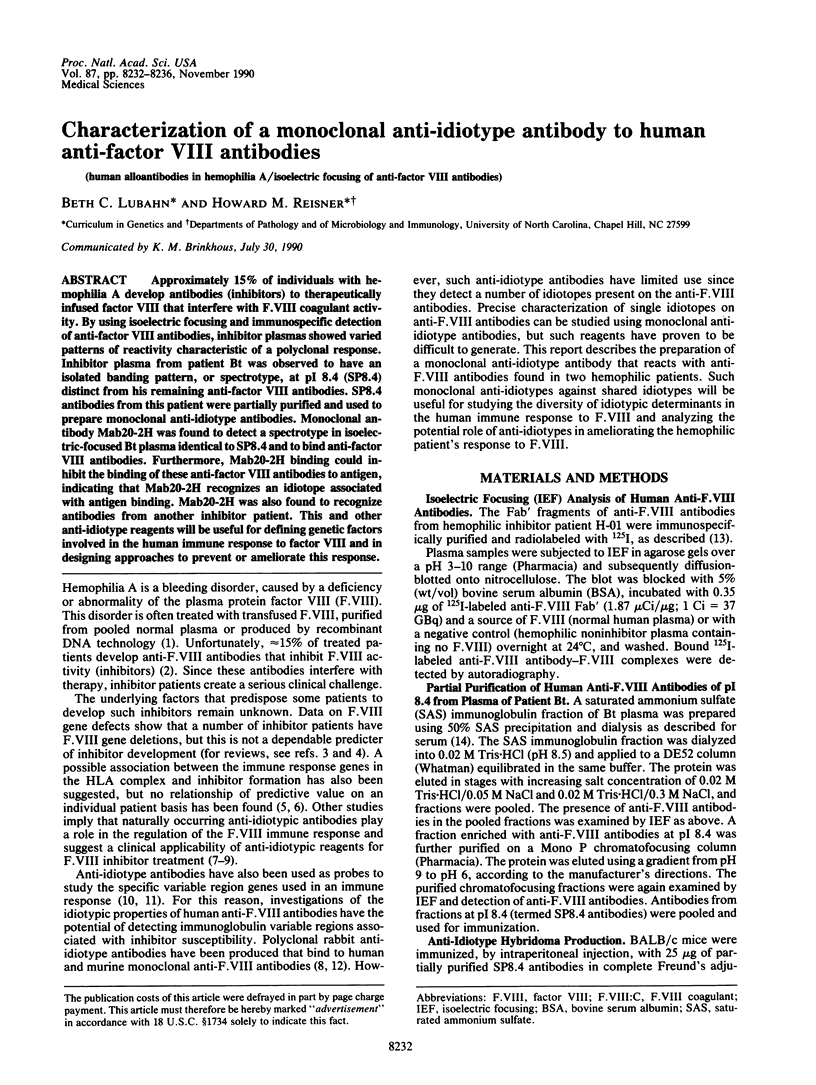
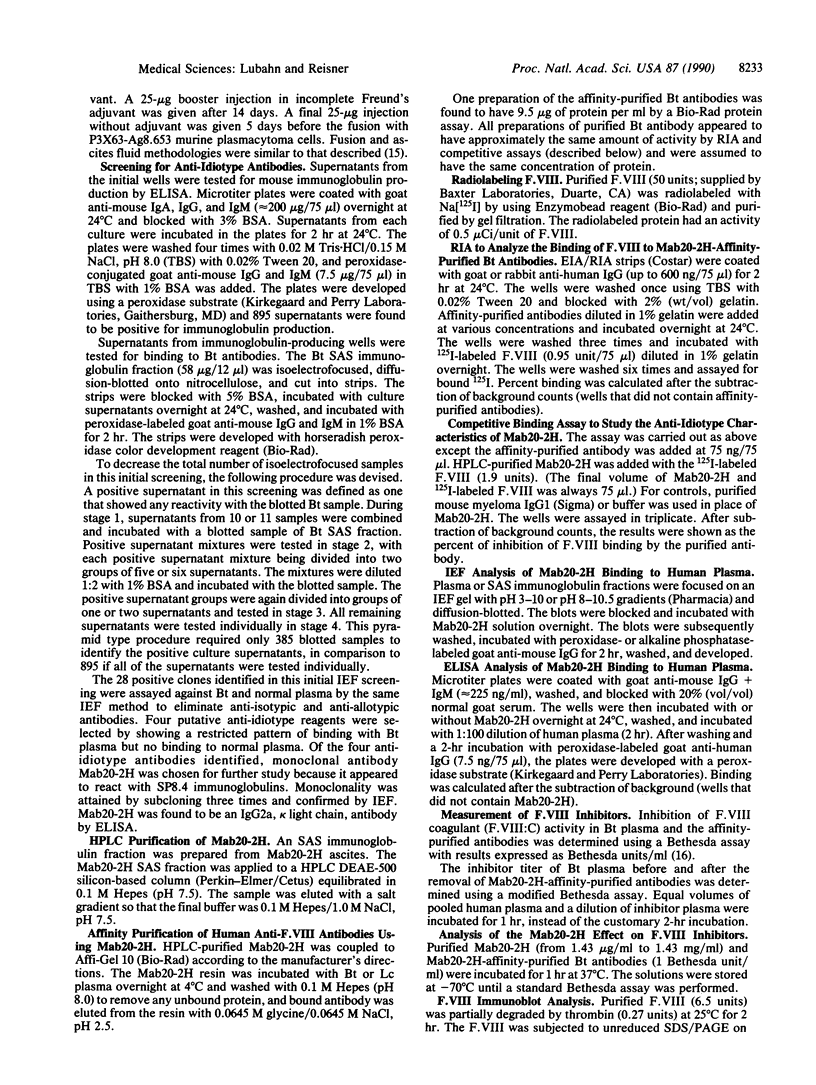
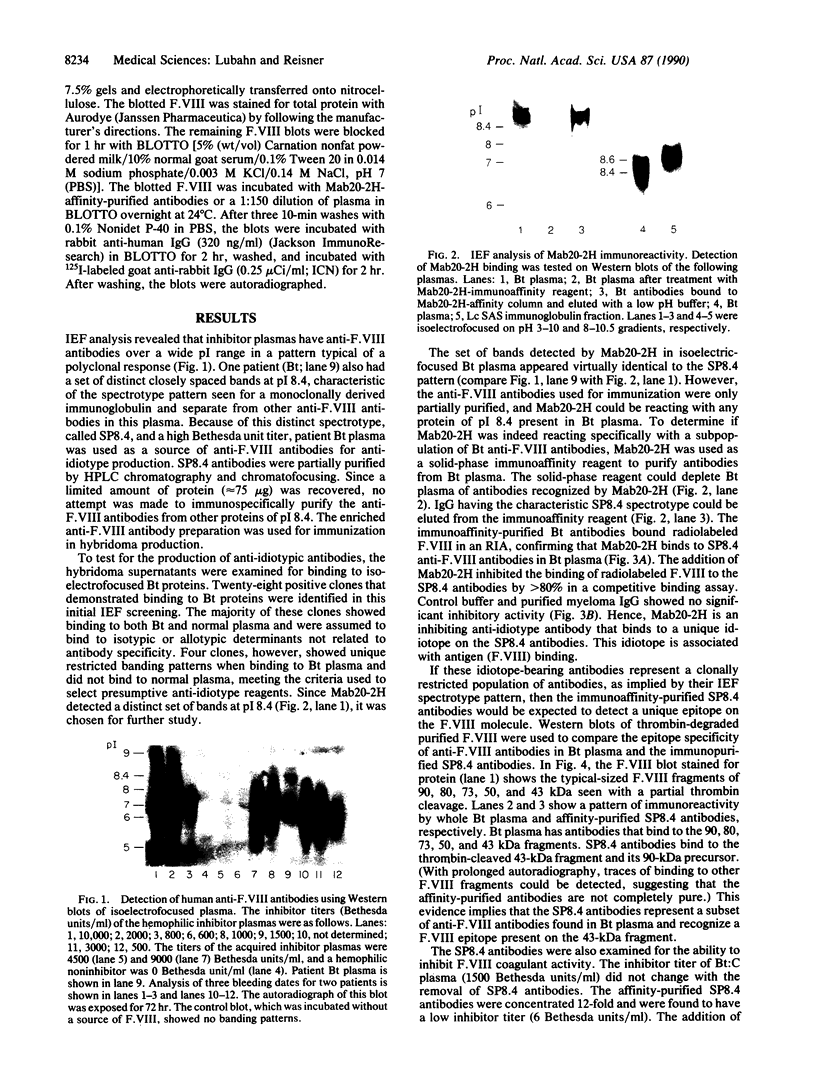
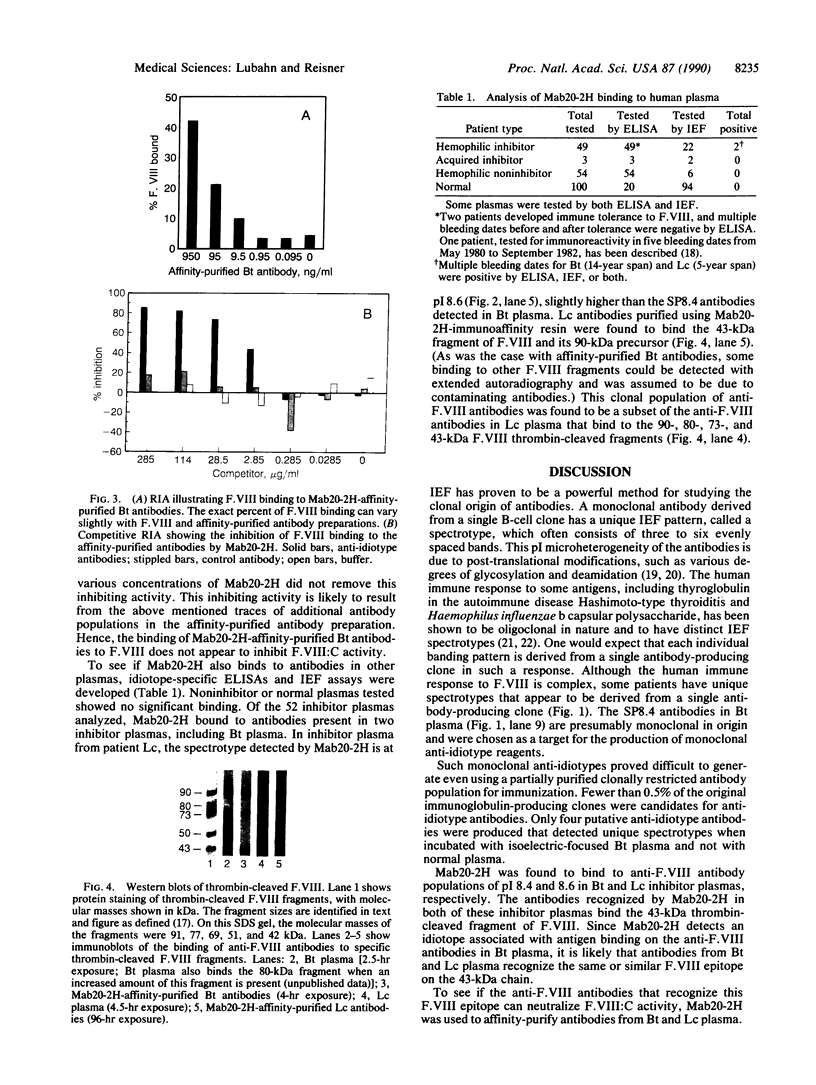
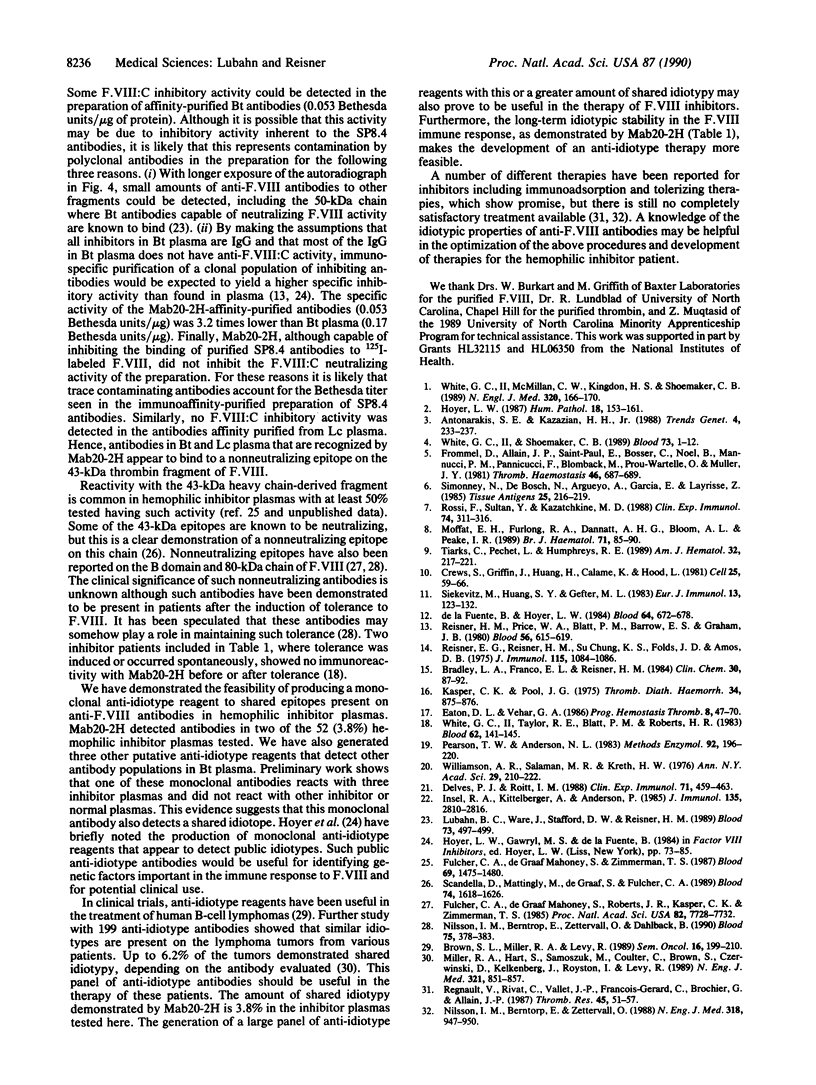
Images in this article
Selected References
These references are in PubMed. This may not be the complete list of references from this article.
- Antonarakis S. E., Kazazian H. H., Jr The molecular basis of hemophilia A in man. Trends Genet. 1988 Aug;4(8):233–237. doi: 10.1016/0168-9525(88)90156-4. [DOI] [PubMed] [Google Scholar]
- Bradley L. A., Franco E. L., Reisner H. M. Use of monoclonal antibodies in an enzyme immunoassay for factor VIII-related antigen. Clin Chem. 1984 Jan;30(1):87–92. [PubMed] [Google Scholar]
- Brown S. L., Miller R. A., Levy R. Antiidiotype antibody therapy of B-cell lymphoma. Semin Oncol. 1989 Jun;16(3):199–210. [PubMed] [Google Scholar]
- Crews S., Griffin J., Huang H., Calame K., Hood L. A single VH gene segment encodes the immune response to phosphorylcholine: somatic mutation is correlated with the class of the antibody. Cell. 1981 Jul;25(1):59–66. doi: 10.1016/0092-8674(81)90231-2. [DOI] [PubMed] [Google Scholar]
- Delves P. J., Roitt I. M. Long term spectrotypic and idiotypic stability of thyroglobulin autoantibodies in patients with Hashimoto's thyroiditis. Clin Exp Immunol. 1988 Mar;71(3):459–463. [PMC free article] [PubMed] [Google Scholar]
- Eaton D. L., Vehar G. A. Factor VIII structure and proteolytic processing. Prog Hemost Thromb. 1986;8:47–70. [PubMed] [Google Scholar]
- Frommel D., Allain J. P., Saint-Paul E., Bosser C., Noël B., Mannucci P. M., Pannicucci F., Blombäck M., Prou-Wartelle O., Muller J. Y. HLA antigens and factor VIII antibody in classic hemophilia. European study group of factor VIII antibody. Thromb Haemost. 1981 Dec 23;46(4):687–689. [PubMed] [Google Scholar]
- Fulcher C. A., de Graaf Mahoney S., Roberts J. R., Kasper C. K., Zimmerman T. S. Localization of human factor FVIII inhibitor epitopes to two polypeptide fragments. Proc Natl Acad Sci U S A. 1985 Nov;82(22):7728–7732. doi: 10.1073/pnas.82.22.7728. [DOI] [PMC free article] [PubMed] [Google Scholar]
- Fulcher C. A., de Graaf Mahoney S., Zimmerman T. S. FVIII inhibitor IgG subclass and FVIII polypeptide specificity determined by immunoblotting. Blood. 1987 May;69(5):1475–1480. [PubMed] [Google Scholar]
- Hoyer L. W., Gawryl M. S., de la Fuente B. Immunochemical characterization of factor VIII inhibitors. Prog Clin Biol Res. 1984;150:73–85. [PubMed] [Google Scholar]
- Hoyer L. W. Molecular pathology and immunology of factor VIII (hemophilia A and factor VIII inhibitors). Hum Pathol. 1987 Feb;18(2):153–161. doi: 10.1016/s0046-8177(87)80333-7. [DOI] [PubMed] [Google Scholar]
- Insel R. A., Kittelberger A., Anderson P. Isoelectric focusing of human antibody to the Haemophilus influenzae b capsular polysaccharide: restricted and identical spectrotypes in adults. J Immunol. 1985 Oct;135(4):2810–2816. [PubMed] [Google Scholar]
- Kasper C. K., Pool J. G. Letter: Measurement of mild factor VIII inhibitors in Bethesda units. Thromb Diath Haemorrh. 1975 Dec 15;34(3):875–876. [PubMed] [Google Scholar]
- Lubahn B. C., Ware J., Stafford D. W., Reisner H. M. Identification of a F.VIII epitope recognized by a human hemophilic inhibitor. Blood. 1989 Feb;73(2):497–499. [PubMed] [Google Scholar]
- Miller R. A., Hart S., Samoszuk M., Coulter C., Brown S., Czerwinski D., Kelkenberg J., Royston I., Levy R. Shared idiotypes expressed by human B-cell lymphomas. N Engl J Med. 1989 Sep 28;321(13):851–857. doi: 10.1056/NEJM198909283211302. [DOI] [PubMed] [Google Scholar]
- Moffat E. H., Furlong R. A., Dannatt A. H., Bloom A. L., Peake I. R. Anti-idiotypes to factor VIII antibodies and their possible role in the pathogenesis and treatment of factor VIII inhibitors. Br J Haematol. 1989 Jan;71(1):85–90. doi: 10.1111/j.1365-2141.1989.tb06279.x. [DOI] [PubMed] [Google Scholar]
- Nilsson I. M., Berntorp E., Zettervall O., Dahlbäck B. Noncoagulation inhibitory factor VIII antibodies after induction of tolerance to factor VIII in hemophilia A patients. Blood. 1990 Jan 15;75(2):378–383. [PubMed] [Google Scholar]
- Nilsson I. M., Berntorp E., Zettervall O. Induction of immune tolerance in patients with hemophilia and antibodies to factor VIII by combined treatment with intravenous IgG, cyclophosphamide, and factor VIII. N Engl J Med. 1988 Apr 14;318(15):947–950. doi: 10.1056/NEJM198804143181503. [DOI] [PubMed] [Google Scholar]
- Pearson T. W., Anderson N. L. Use of high-resolution two-dimensional gel electrophoresis for analysis of monoclonal antibodies and their specific antigens. Methods Enzymol. 1983;92:196–220. doi: 10.1016/0076-6879(83)92019-0. [DOI] [PubMed] [Google Scholar]
- Regnault V., Rivat C., Vallet J. P., Francois-Gerard C., Brochier G., Allain J. P. A potential new procedure for removing anti-factor VIII antibodies from hemophilic plasma. Thromb Res. 1987 Jan 1;45(1):51–57. doi: 10.1016/0049-3848(87)90256-8. [DOI] [PubMed] [Google Scholar]
- Reisner E. G., Reisner H. M., Chung K. S., Folds J. D., Amos D. B. Analysis of an HL-A antiserum by iso-electric focusing. J Immunol. 1975 Oct;115(4):1084–1086. [PubMed] [Google Scholar]
- Reisner H. M., Price W. A., Blatt P. M., Barrow E. S., Graham J. B. Factor VIII coagulant antigen in hemophilic plasma: a comparison of five alloantibodies. Blood. 1980 Oct;56(4):615–619. [PubMed] [Google Scholar]
- Rossi F., Sultan Y., Kazatchkine M. D. Anti-idiotypes against autoantibodies and alloantibodies to VIII:C (anti-haemophilic factor) are present in therapeutic polyspecific normal immunoglobulins. Clin Exp Immunol. 1988 Nov;74(2):311–316. [PMC free article] [PubMed] [Google Scholar]
- Scandella D., Mattingly M., de Graaf S., Fulcher C. A. Localization of epitopes for human factor VIII inhibitor antibodies by immunoblotting and antibody neutralization. Blood. 1989 Oct;74(5):1618–1626. [PubMed] [Google Scholar]
- Siekevitz M., Huang S. Y., Gefter M. L. The genetic basis of antibody production: a single heavy chain variable region gene encodes all molecules bearing the dominant anti-arsonate idiotype in the strain A mouse. Eur J Immunol. 1983 Feb;13(2):123–132. doi: 10.1002/eji.1830130207. [DOI] [PubMed] [Google Scholar]
- Simonney N., De Bosch N., Argueyo A., Garcia E., Layrisse Z. HLA antigens in hemophiliacs A with or without factor VIII antibodies in a Venezuelan Mestizo population. Tissue Antigens. 1985 Apr;25(4):216–219. doi: 10.1111/j.1399-0039.1985.tb00440.x. [DOI] [PubMed] [Google Scholar]
- Tiarks C., Pechet L., Humphreys R. E. Development of anti-idiotypic antibodies in a patient with a factor VIII autoantibody. Am J Hematol. 1989 Nov;32(3):217–221. doi: 10.1002/ajh.2830320311. [DOI] [PubMed] [Google Scholar]
- White G. C., 2nd, McMillan C. W., Kingdon H. S., Shoemaker C. B. Use of recombinant antihemophilic factor in the treatment of two patients with classic hemophilia. N Engl J Med. 1989 Jan 19;320(3):166–170. doi: 10.1056/NEJM198901193200307. [DOI] [PubMed] [Google Scholar]
- White G. C., 2nd, Shoemaker C. B. Factor VIII gene and hemophilia A. Blood. 1989 Jan;73(1):1–12. [PubMed] [Google Scholar]
- White G. C., 2nd, Taylor R. E., Blatt P. M., Roberts H. R. Treatment of a high titer anti-factor-VIII antibody by continuous factor VIII administration: report of a case. Blood. 1983 Jul;62(1):141–145. [PubMed] [Google Scholar]
- de la Fuente B., Hoyer L. W. The idiotypic characteristics of human antibodies to factor VIII. Blood. 1984 Sep;64(3):672–678. [PubMed] [Google Scholar]






